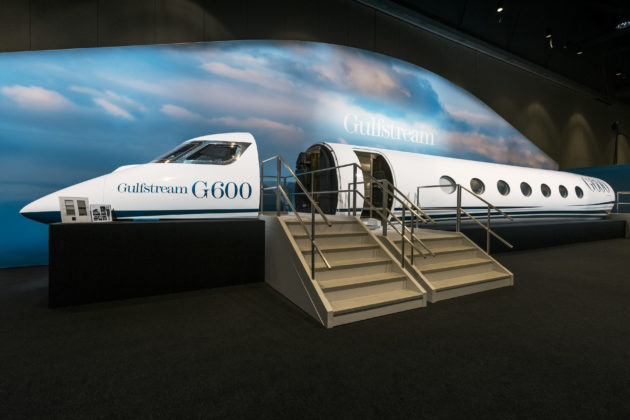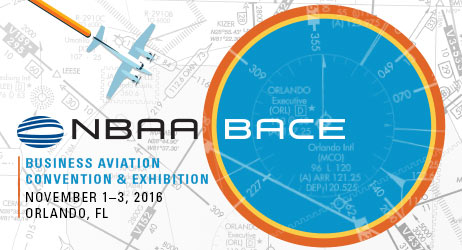NBAA 2016, Business Aviation, G600 Technical Description, G280 Record, US Flight Activity
Posted on October 28th, 2016
We always keep up to date with training, education, and news about our industry to better serve our clients. These are some of the some of the business aviation news articles and stories that grabbed our attention this week:
NBAA’s 2016 Convention Set to Return to Orlando
It’s no surprise that this year’s NBAA Business Aviation Convention and Exhibition (November 1 to 3) will be held at the Orange County Convention Center in Orlando, Fla. After all, the show is ranked sixth largest in the U.S., and there are not many places with a large enough facility and a nearby airport for the static display. For the next few years, the show will bounce back and forth between Orlando and Las Vegas.
Visitors will notice one big difference this year: the host FBO is still the same facility at Orlando Executive Airport, but it is now owned by Atlantic Aviation, which purchased the former Showalter Flying Services FBO early last year.
Dozens of aircraft are expected at the static display at Atlantic Aviation, and this includes some unusual candidates such as a SPAD XIII World War I biplane at the Dassault Falcon display (a young Marcel Dassault designed its propeller) and the first NBAA appearance of the Pilatus PC-24 light jet. Gulfstream is bringing seven aircraft this year, including the new fly-by-wire G500, which is making its first appearance at an NBAA show. Joining the SPAD at the Dassault Falcon display are five jets, including the Falcon 8X, and the 5X mockup. Bombardier will also bring seven jets, including two Learjet 75s, two Challenger 650s and a 350 and a Global 5000 and 6000. Textron Aviation is bringing the most airplanes from one manufacturer, 11 turbine-powered airplanes ranging from the Caravan EX turboprop to the Citation X+ jet and its new Longitude as well as a cabin mockups for the in-development Citation Hemisphere large-cabin jet. The convention center will also host more aircraft at the indoor static display.
Continue reading about NBAA 2016 on AINOnline ->
Why America still needs business aviation
As the industry prepares to gather for the annual National Business Aviation Association convention in Orlando, the US economy is seven years into a post-2008 upswing – but facing the uncertainty of a presidential election in which there is a chance that the most maverick and unpredictable candidate of modern times could emerge as Commander in Chief. At the same time, in the wider global economy, the BRICS engines of growth are backfiring.
For business aviation manufacturers, this has meant a sharp fall in orders and deliveries of large-cabin business jets, including the airliner-derived offerings from Airbus and Boeing. Much of the demand for these top-end types had come from newly-bullish billionaires in Brazil, China, and Russia, many of whom are feeling less confident about their fortunes than two years ago. That means they are less prepared to invest in assets they may not need and which – unlike many of their other discretionary acquisitions – are not guaranteed to appreciate. This has, in turn, put severe downward pressure on values, with reports of recently-minted long-range aircraft being offered on the used market at a fraction of their list prices.
Better news comes from segments that looked beleaguered in the years after the financial crisis – the super-light to super-midsize workhorses of business aviation – and from an ownership model that also looked to have had its day: fractionals. The reason is that – after many years of hoarding cash, during which travel on private jets was often tainted by undertones of executive excess – corporate America is turning again to corporate aircraft, embracing the “no plane no gain” message of NBAA.
Continue reading this business aviation article on FlightGlobal->
Gulfstream G600 technical description
When Gulfstream sent out invitations to a public event in Savannah, Georgia, on 14 October 2014, everyone expected to see the unveiling of a new aircraft. Rumors and internet mentions of Gulfstream’s secretive P42 project had been swirling for several years, suggesting a replacement for the G450/550 was already deep in development.
On the appointed day, Gulfstream fulfilled those expectations by dramatically “rolling-in” the prototype of the G500 into a newly constructed, black-draped final assembly hangar filled with thousands of employees and guests. The surprise of the highly anticipated event was the revelation that the company was also developing a second aircraft – the G600.
The G500/600 would follow a proven Gulfstream formula. The GV entered the market in the late 1990s as a stretched and longer-range version of the GIV, which had first appeared a decade earlier. Early in the 2000s, Gulfstream replaced the GIV/GV with another pairing in the G450/G550, although both were derivatives retaining the 30-year-old fuselage cross-section and wing design of the original GIV.

As the aircraft designations suggest, the G500 and G600 represent the beginning of a new aircraft family, rather than yet another derivative of the classic GIV. Not for nothing has Gulfstream omitted a G400 from its future product line-up. Rather than directly replace the G450/550 with improved models, the G500 and G600 bracket the performance and cabin size of the G550, while the G600 is positioned between the G550 and the ground-breaking G650, which entered service in 2012.
The sizing metrics neatly align with the G600’s positioning in the Gulfstream product line-up. As a clean-sheet design, the G500 and G600 share the same fuselage cross-section of 2.41m (7ft 11in), which splits the difference between the G550 and G650. The G600’s cabin is 17.8cm wider than the G550 and 17.8cm narrower than the G650. The additional width of the G650 provides a nearly 12% advantage over the G600 in cabin volume, despite only a 45cm difference in cabin length.
Gulfstream G280 Achieves Remarkable 57th World Speed Record — A Testament To Exceptional Performance
Guernsey-To-Teterboro Trip Completed In Seven Hours And 26 Minutes
Gulfstream Aerospace Corp. today announced that its Gulfstream G280 aircraft recently established a speed record between Guernsey, one of the Channel Islands in Europe, and Teterboro, New Jersey, making the trans-Atlantic journey in just seven hours and 26 minutes.
The super mid-size business jet departed Guernsey Airport at 7:54 a.m. local time and arrived at Teterboro Airport at 10:20 a.m. local time, completing the 3,216-nautical-mile/5,956-kilometer flight at an average speed of Mach 0.80.
“This flight showcased the G280’s outstanding takeoff performance,” said Scott Neal, senior vice president, Worldwide Sales, Gulfstream. “Guernsey’s available takeoff distance is less than 5,200 feet, yet the G280 was able to make this trip with plenty of room to spare. One of the many benefits of the G280 is being able to use smaller airports and runways around the world without sacrificing range and speed.”
Continue reading about the G280 world speed record on Gulfstreamnews.com->
US business aviation bounces back
The business aviation community will converge on Orlando, Florida, from 1 to 3 November for the industry’s largest annual showcase, the NBAA Business Aviation Convention and Exhibition (BACE).
It is fitting that the USA – home to the world’s largest population of business aircraft owners and manufacturers – has played host to this vast, iconic show since its conception 69 years ago.
The importance of the US market cannot be understated. Flight Fleets Analyzer records an installed base of around 18,000 business jets and turboprops, which represents 60% of the global fleet.
The region consistently accounts for more than half of new aircraft deliveries each year, with small and midsize-category models making up the bulk of the shipments.
Analyzer records a year-on-year hike in turbine aircraft deliveries to US customers since 2012, from 445 units to 580 in 2015. While this is significantly down from the 2008 market peak of nearly 930 units, the US is faring better than the rest of the world, where only 394 aircraft shipped in 2015.
“The USA has all the ingredients for a thriving aviation market, not least a vast customer base and a robust infrastructure to support the fleet,” says Peter Bunce, chief executive of the industry trade body General Aviation Manufacturers Association.
US activity up year-over-year, down month-over-month
According to ARGUS International’s latest TRAQPak data, the US and Canadian flight activity in September were up 4.6% year-over-year (YOY), with charter flight activity leading the way, but down month-over-month (MOM) from August with 5.5%.
MOM results by operational category were down for the month, with Part 91 down 2.4%, Part 135 down 8.0% and Fractional activity down 10.2%. The aircraft categories were mostly down MOM with the exception of large-cabin aircraft, up 1.0% from August.
Continue reading this article about US flight activity on fly-corporate.com->
Tags: G280, business aviation outlook, G600, aviation news, bizav news, NBAA 2016, US flight activity, gulfstream, business aviation


[…] a speech given at NBAA 2016, Peggy Gilligan, associate administrator for aviation safety for the FAA, gave the business […]